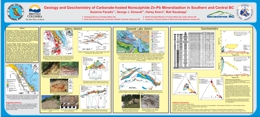| Publication Summary
|
| Issue ID: | GF2011-04 |
| Title: | Geology and Geochemistry of Carbonate-hosted Nonsulphide Zn-Pb Mineralization in Southern and Central B.C. |
| Author(s): | Paradis, S., Simandl, G.J., Keevil, H., Raudsepp, M. |
| Series Name: | GeoFile |
| Publication Year: | 2011 |
| NTS Map Sheet(s): | 082;083;092;093;094;102;103;104;114 |
| Place Keyword(s): | British Columbia |
| Lat/Long (NSWE): | 60, 48, -140, -114 |
| Theme Keyword(s): | carbonate-hosted, nonsulphide, Zn-Pb |
| Download(s): | |
Abstract:  | Carbonate-hosted, nonsulphide base metal deposits of the Kootenay terrane (Salmo district), adjacent Cariboo terrane (Quesnel Lake district), and elsewhere in BC have near-surface Zn- and Pb-bearing iron oxide-rich gossans formed by supergene processes. The nonsulphide deposits of the Salmo district, which occur mainly as large irregular replacement masses, encrustations, or open-space fillings, consist predominantly of Fe-oxyhydroxides, goethite, hematite, hemimorphite, and minor smithsonite, hydrozincite and cerussite. They contain 0.8-23% Zn, 0.7-5% Pb, and >20% Fe. Deposits of the Quesnel Lake district consist of pervasive fine-grained sulphide and nonsulphide disseminations and aggregates forming pods and masses, sulphide- and nonsulphide-bearing quartz (ącalcite) veins, and crackle breccias. Sulphides are galena, sphalerite, and trace amounts of pyrite. Nonsulphides are smithsonite, hemimorphite, cerussite, hydrozincite, and anglesite. Grab samples assayed 17.3-51.0% Zn, 0.1-1.5% Pb, and 0.4-0.8% Fe. In most occurrences of both districts, the spatial continuity and/or the close spatial relationships in combination with morphological similarities between sulphide and associated nonsulphide zones suggest direct replacement of sulphides by nonsulphide base metal-bearing minerals. |





